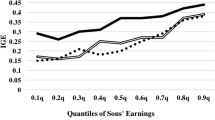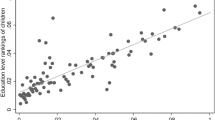Abstract
This study examines the relationship between education and intergenerational income mobility in urban China based on the data of Chinese Urban Household Education and Employment Survey (CHUHEES)—2004” by Institute of Economics of Education of Peking University. It analyzes the characteristics of the intergenerational income mobility of Chinese urban household through such indices as intergenerational income inheritance and mobility, and intergenerational income elasticity, exploring the role of education to promote intergenerational income mobility through pathanalysis and binary logistic regression. It also analyzes the changing tendency along with the progress of the market reform in China and tries to provide theoretical explanations for the empirical results. According to the findings, there is rather obvious intergenerational income transmission in urban China, and most children still resort in the same income group with their fathers. As a kind of important mechanism of intergenerational mobility, education is instrumental to promote children of disadvantage group to upgrade of their economic status, showing its strong functions to promote intergenerational upward mobility. With the improvement of the level of marketization together with appropriate social policy, the role of education to promote the intergenerational income mobility and social equity is getting stronger.
摘要
利用北京大学教育经济研究所 《中国城镇居民教育与就业情况调查—2004》 的数据, 对中国城镇居民教育与收入代际流动的关系进行定量研究。 通过收入代际继承性和流动性指数、 收入代际弹性系数等指标分析中国城镇居民收入代际流动的特点, 运用通径分析技术和二元Logistic 回归模型探讨教育促进收入代际流动的功能, 分析教育的这一功能随中国市场化水平的提高所呈现出的变化趋势, 并对研究结果进行原因解释。 研究结果表明, 中国城镇居民收入代际存在较为明显的传递效应, 多数子女依然滞留在与父亲相同的收入组群; 教育作为一种重要的代际流动机制, 有助于促进弱势群体的子女实现经济社会地位的跃升, 具有较强的促进代际流动的功能; 随着市场化水平的提高, 教育促进收入代际流动, 改善整个社会收入公平状况的功能也日益增强。
Similar content being viewed by others
References
Anders B, Chadwick L (2003). Intergenerational income mobility in permanent and separated families. Economics Letters, (80): 239–246
Anders B, Jantti M (1997). Intergenerational income mobility in Sweden compared to the United States. The American Economic Review, 87(5): 1009–1018
Aughinbaugh A (2000). Reapplication and extension intergenerational mobility in the United States. Labor Economics, 7(6): 785–796
Chadwick L, Solon G (2002). Intergenerational income mobility among daughters. The American Economic Review, 92(1): 335–344
Chen X Y (1999). Cost Compensation of China’s Higher Education. Doctoral thesis, School of Education, Peking University
Corak M, Heisz A (1999). The intergenerational earnings and income mobility of Canadian men evidence from longitudinal income tax data. the Journal of Human Resources, 34(3): 504–533
Couch, A K, Lillard R D (1998). Sample selection rules and the intergenerational correlation of earnings. Labor Economics, 5(3): 313–329
Das M, Sjogren T (2002). The inter-generational link in income mobility evidence from adoptions. economics Letter, 75(1): 55–60
Dearden L, Mchin S, Reed H (1997). Intergenerational mobility in Britain. The Economic Journal, 107(440): 47–66
Elizabeth H P (1992). Patterns of intergenerational mobility in income and earnings. The Review of Economics and Statistics, 74(3): 456–466
Guo C B, Ding X H (2004). Labor market segmentation and role of educaiton in occupational intergenerational effect. Economics, (4):24–28
Guo Z G (2003). SPSS Softward Application—Social Statistics Analysis Methods. People’s University Press (in Chinese)
Levine D I, Mazumder B (2002). Choosing the Right Parents: Changes in the Intergenerational Transmission of Inequality Between 1980 and the Early 1990s. Federal Reserve Bank of Chicago, August, 2002–08
Nam Yunju (2004). Is America becoming more equal for children changes in the intergenerational transmission of low-and highincome status. Social Science Research, 33(2): 187–205
Solon G (1992). Intergenerational income mobility in the United States. the American Economic Review, (3): 393–408
Solon G (2002). Cross country differences in intergenerational earnings mobility. the Journal of Economic Perspectives, 16(3): 59–66
Xu X X (2004). Changes in Chinese social structure from the perspective of occupational evaluation and job tendency—Annex 1 China’s social/economic status index. In Li P L ed. Chinese Society Categorization. Beijing: Social Sciences Academic Press, 153–156 (in Chinese)
Author information
Authors and Affiliations
Corresponding author
Additional information
__________
Translated from Jiaoyu Yanjiu 教育研究 (Educational Research), 2007, (5): 3–14
Rights and permissions
About this article
Cite this article
Guo, C., Min, W. Education and intergenerational income mobility in urban China. Front. Educ. China 3, 22–44 (2008). https://doi.org/10.1007/s11516-008-0002-x
Issue Date:
DOI: https://doi.org/10.1007/s11516-008-0002-x




